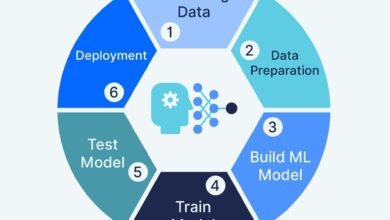
The exponential growth of artificial intelligence and machine learning has revolutionized how businesses operate, creating unprecedented opportunities for innovation and efficiency. However, this technological advancement comes with a significant challenge: managing the substantial cloud computing costs associated with machine learning projects. Organizations worldwide are grappling with spiraling expenses as they scale their ML initiatives, with some companies reporting monthly cloud bills reaching hundreds of thousands or even millions of dollars. The computational intensity of training deep learning models, coupled with the need for powerful GPU instances and massive storage requirements, has made cloud cost optimization not just a nice-to-have, but an absolute business imperative.
Cloud cost optimization for machine learning projects involves implementing strategic approaches to minimize expenses while maintaining or even enhancing model performance and training efficiency. Unlike traditional application workloads, ML projects present unique cost challenges due to their intensive compute requirements, long-running training jobs, large dataset storage needs, and experimental nature that often leads to resource wastage. The good news is that with proper planning, monitoring, and implementation of best practices, organizations can achieve cost reductions ranging from 30% to 90% without compromising their machine learning capabilities.
This comprehensive guide explores proven strategies and actionable techniques for optimizing cloud infrastructure costs in machine learning environments. Whether you’re running model training on AWS, Google Cloud Platform, or Microsoft Azure, knowing how to leverage spot instances, right-size your compute resources, optimize data storage, and implement intelligent monitoring can transform your cloud spending from a budget-draining liability into a strategic advantage. We’ll delve into practical approaches that data scientists, ML engineers, and DevOps teams can implement immediately, backed by real-world examples and industry best practices. From selecting the right instance types to automating cost-saving workflows, this article provides a roadmap for achieving sustainable, cost-effective machine learning operations in the cloud.
Cloud Costs in Machine Learning Projects
The Unique Cost Structure of ML Workloads
Machine learning projects differ fundamentally from traditional cloud applications in their resource consumption patterns. Unlike web applications that may run continuously with predictable traffic, ML workloads are characterized by intensive compute-heavy training phases that require substantial GPU or TPU resources, followed by relatively lighter inference periods. The cost structure reflects this unique pattern, with expenses concentrated in several key areas.
GPU and accelerator costs typically represent the largest portion of ML cloud spending. Training deep neural networks, natural language processing models, or computer vision systems demands high-performance computing hardware that can cost anywhere from $1 to $30 per hour, depending on the instance type. A single large-scale model training run might require days or weeks of continuous GPU usage, translating to thousands of dollars per experiment. When teams run multiple experiments for hyperparameter tuning or model architecture exploration, these costs multiply rapidly.
Storage expenses constitute another significant cost driver in machine learning infrastructure. ML projects require vast amounts of data storage for training datasets, validation sets, model checkpoints, experiment logs, and model artifacts. Large vision datasets can exceed terabytes, while natural language processing corpora may require even more space. Storage costs accumulate quickly, especially when teams maintain multiple versions of datasets or fail to implement proper data lifecycle management.
Common Cost Pitfalls in ML Development
Many organizations unknowingly fall into common traps that inflate their cloud computing expenses. One prevalent issue is idle resource waste, where expensive GPU instances continue running after training jobs complete because of missing automatic shutdown mechanisms. Research indicates that 30-40% of cloud resources in ML environments remain idle or underutilized, representing pure financial waste.
Over-provisioning represents another costly mistake. Teams often select powerful instance types “just to be safe,” paying premium prices for capabilities they never utilize. A p3.16xlarge instance with 8 GPUs might cost $24 per hour, but if your model training only effectively uses 2-3 GPUs, you’re wasting 60-70% of your budget. Similarly, allocating excessive memory or storage “buffer space” adds unnecessary costs without delivering value.
The experimental nature of machine learning development exacerbates cost challenges. Data scientists typically run dozens or hundreds of experiments to optimize model performance, and without proper cost monitoring and governance, these experiments can generate surprising bills. Failed experiments that crash midway through still incur full costs, and forgotten background jobs continue consuming resources indefinitely.
Strategic Approaches to Cloud Cost Optimization
Implementing Right-Sizing for ML Workloads
Right-sizing is the practice of matching your compute resources precisely to your workload requirements, ensuring you’re neither over-paying for unused capacity nor under-provisioning and throttling performance. For machine learning workloads, this requires the specific resource demands of different ML phases.
Start by profiling your training jobs to identify actual resource utilization. Most cloud providers offer monitoring tools that track CPU usage, GPU utilization, memory consumption, and I/O patterns. Tools like AWS CloudWatch, Google Cloud Monitoring, or Azure Monitor provide detailed metrics that reveal whether your instances are appropriately sized. If your GPU utilization consistently stays below 70%, you’re likely over-provisioned and can downgrade to a smaller instance type.
Consider separating different ML pipeline stages onto optimized infrastructure. Data preprocessing and feature engineering often benefit from CPU-optimized instances rather than expensive GPU machines. Model inference typically requires less powerful hardware than training, so deploying your trained models on smaller, CPU-based instances can yield significant savings. By segmenting your pipeline and matching each stage to appropriate instance types, you optimize costs across the entire machine learning workflow.
Memory requirements deserve special attention in cost optimization strategies. Many ML frameworks cache data in memory to accelerate training, but excessive memory allocation drives up costs unnecessarily. Analyze your actual memory usage patterns and select instances with appropriate RAM. If your training job uses only 32GB of a 256GB instance, you’re paying a premium for unused capacity that could be eliminated through better instance selection.
Leveraging Spot Instances and Preemptible VMs
Spot instances (AWS), preemptible VMs (Google Cloud), and spot VMs (Azure) offer the single most impactful opportunity for cloud cost reduction in machine learning projects. These services provide access to spare cloud capacity at discounts of 50-90% compared to on-demand pricing, making them exceptionally attractive for cost-conscious ML teams.
Spot instances enable access to spare compute capacity at steep discounts compared to on-demand rates, with platforms like Amazon SageMaker managing spot interruptions and potentially optimizing training costs up to 90%. For a GPU instance that normally costs $14.40 per hour on-demand, spot pricing might drop to $4.32 per hour or less—a 70% cost reduction that can save thousands of dollars per training run.
The primary tradeoff with spot instances is their interruptible nature. Cloud providers can reclaim these instances with short notice (typically 2 minutes) when they need the capacity for on-demand customers. This characteristic makes spots perfect for fault-tolerant workloads like ML training, where jobs can be checkpointed and resumed. Modern ML frameworks like TensorFlow and PyTorch support automatic checkpointing, allowing training to pause, save progress, and continue on a new instance after interruption.
Implementing spot instances effectively requires architectural considerations. Design your training pipeline to save model checkpoints frequently—every 10-30 minutes is common practice. When an interruption occurs, your job can resume from the latest checkpoint rather than restarting completely. Use spot instances for hyperparameter tuning runs where multiple parallel experiments can tolerate interruptions independently. Reserve on-demand instances only for time-critical production training or jobs that absolutely cannot tolerate interruption.
For maximum savings, combine spot instances with instance diversification. Don’t rely on a single instance type; instead, configure your system to accept multiple instance families and sizes. This flexibility increases your chances of obtaining spot capacity and reduces interruption frequency. Many organizations report running 80-95% of their ML training workloads on spot instances once they’ve implemented proper checkpointing and diversification strategies.
Optimizing Data Storage Costs
Storage optimization represents a frequently overlooked opportunity in cloud cost management for machine learning. While compute costs grab attention, storage expenses silently accumulate and can constitute 20-30% of total ML infrastructure spending.
Implement intelligent data lifecycle policies to automatically transition data between storage tiers. Most cloud providers offer multiple storage classes with different cost-performance characteristics. Hot storage (frequently accessed) costs more but provides immediate access, while cold storage (rarely accessed) costs significantly less with retrieval delays. After initial model training, move datasets to cheaper storage tiers if they’re only accessed occasionally for retraining or validation.
Data deduplication and compression reduce storage requirements substantially. ML datasets often contain significant redundancy—multiple versions of similar images, repeated text patterns, or unnecessary metadata. Implementing compression can reduce storage needs by 50-80% depending on data type, directly translating to proportional cost savings. Modern compression algorithms like Zstandard or LZ4 offer excellent compression ratios while maintaining fast decompression speeds that don’t bottleneck training.
Delete unnecessary data aggressively. Many teams accumulate experimental datasets, failed model checkpoints, temporary training artifacts, and outdated logs that consume expensive storage indefinitely. Implement automated cleanup policies that remove data after defined retention periods. Maintain only your final trained models, essential datasets, and recent experiment logs. This disciplined approach prevents storage costs from growing unchecked over time.
Advanced Optimization Techniques

Distributed Training and Model Parallelism
Distributed training enables faster model training by spreading computation across multiple GPUs or machines, but it also offers cost optimization opportunities when implemented strategically. By completing training jobs faster, you reduce the total hours of compute time consumed, which can offset the increased number of instances used.
Data parallelism, where different GPUs process different data batches simultaneously, represents the most common distributed training approach. This technique scales well for many model architectures and can reduce training time by 50-80% when properly implemented. However, realize that doubling your GPU count rarely halves training time due to communication overhead between instances. Analyze your scaling efficiency to ensure you’re achieving genuine cost benefits rather than simply multiplying your instance costs.
Model parallelism, where different parts of a large model are distributed across multiple GPUs, becomes necessary for models too large to fit in single-GPU memory. This approach enables training larger models that would otherwise be impossible, but it requires careful optimization to minimize communication overhead. When implementing model parallelism, focus on minimizing cross-GPU data transfer and maximizing computational overlap to achieve cost-effective scaling.
Consider gradient accumulation as a cost-effective alternative to scaling up hardware. This technique simulates larger batch sizes by accumulating gradients over multiple forward passes before updating model weights. You can achieve similar training dynamics to larger, more expensive instances by using smaller instances with gradient accumulation. This approach trades slightly longer training time for substantially lower per-hour costs, often resulting in net savings.
Automated Scaling and Resource Management
Automated scaling eliminates manual intervention in resource management, ensuring you provision exactly the capacity needed when it’s needed and scale down during idle periods. This automation is crucial for cost optimization because human oversight inevitably leaves resources running unnecessarily during nights, weekends, or between experiments.
Implement auto-shutdown policies for development and experimentation environments. Configure instances to automatically terminate after periods of inactivity—typically 30-60 minutes without active training jobs. This simple measure alone can reduce development environment costs by 60-80% by eliminating the common scenario where data scientists start training jobs then leave instances running overnight or over weekends.
Kubernetes-based orchestration platforms like Kubeflow or Amazon SageMaker provide sophisticated autoscaling capabilities for ML workloads. These platforms can automatically provision resources when training jobs are submitted and release them upon completion. They support advanced features like gang scheduling (ensuring all resources for distributed jobs start together) and resource quotas (preventing runaway experiments from consuming unlimited resources).
Leverage serverless computing for inference workloads where appropriate. Services like AWS Lambda, Google Cloud Functions, or Azure Functions charge only for actual compute time consumed, with no costs during idle periods. For ML inference APIs with intermittent traffic, serverless deployment can reduce costs by 70-90% compared to maintaining dedicated instances. However, consider cold start latency and throughput requirements when evaluating serverless options.
Experiment Tracking and Cost Attribution
Implementing robust experiment tracking systems creates accountability and visibility that naturally drives better cost management. When teams can see exactly how much each experiment costs, they make more economical decisions about which experiments to run and how to configure them.
Tools like MLflow, Weights & Biases, or Neptune.ai track experiment metadata, including duration, instance types used, and associated costs. By analyzing this data, teams identify cost-inefficient experiments and optimize their configurations. You might discover that certain hyperparameter ranges consistently yield poor results but consume significant resources, allowing you to eliminate those wasteful experiments from future runs.
Cost attribution at the project or team level encourages responsible resource usage. Implement tagging strategies that associate cloud resources with specific teams, projects, or cost centers. When individual teams see their monthly cloud bills broken down by activity, they become motivated to optimize. This transparency often reveals surprising patterns—perhaps one team’s experimental work consumes 60% of the ML infrastructure budget, prompting reevaluation of their approach.
Set up automated cost alerts that notify teams when spending exceeds predefined thresholds. Rather than discovering unexpectedly high bills at month-end, real-time alerts enable immediate intervention when something goes wrong—a training job stuck in an infinite loop, an instance left running accidentally, or an experiment consuming far more resources than expected. These alerts prevent small oversights from becoming expensive mistakes.
Platform-Specific Optimization Strategies
AWS Cost Optimization for Machine Learning
Amazon Web Services offers extensive capabilities for machine learning cost optimization through services like Amazon SageMaker, EC2 spot instances, and various storage tiers. AWS-specific features enable substantial savings for teams operating in this environment.
Amazon SageMaker Savings Plans provide significant discounts (up to 64%) in exchange for committing to consistent usage over one or three-year terms. If your organization has predictable, steady-state ML workloads that will continue long-term, Savings Plans deliver guaranteed cost reductions without architectural changes. Analyze your usage patterns over recent months to determine appropriate commitment levels that maximize savings without over-committing.
Amazon SageMaker’s Managed Spot Training feature makes it easy to train machine learning models using managed EC2 Spot instances, potentially optimizing training costs up to 90% compared to on-demand instances. SageMaker handles spot interruptions automatically, managing checkpointing and job resumption without requiring custom code. This managed approach makes spot instances accessible even for teams without deep infrastructure expertise.
S3 Intelligent-Tiering automatically moves data between access tiers based on usage patterns, eliminating manual lifecycle management. For ML datasets that have varying access patterns—frequently accessed during active projects then rarely touched afterward—Intelligent-Tiering ensures optimal storage costs without administrative overhead. The service monitors object access patterns and transitions data to appropriate tiers automatically.
Leverage AWS Elastic Inference for cost-effective model inference. This service attaches fractional GPU acceleration to EC2 instances or SageMaker endpoints, providing just enough acceleration for inference workloads without requiring full, expensive GPU instances. For inference-heavy applications, Elastic Inference can reduce costs by 50-75% compared to standard GPU instance deployment.
Google Cloud Platform ML Cost Management
Google Cloud Platform provides unique cost optimization capabilities through services like Google Cloud AI Platform, preemptible VMs, and TPU pricing options. GCP’s architecture and pricing model offer distinct advantages for certain ML workload types.
TPUs (Tensor Processing Units) provide Google’s custom-designed ML accelerators optimized specifically for TensorFlow workloads. For compatible models, TPUs offer superior price-performance compared to GPU instances, sometimes delivering 5-10x better cost efficiency. However, not all models benefit equally from TPUs—they excel at large-scale matrix operations common in neural networks but may not accelerate every ML algorithm. Evaluate TPU performance for your specific models to determine whether migration would yield cost savings.
Google Cloud Preemptible VMs function similarly to AWS spot instances, offering 60-91% discounts compared to regular instances. GCP’s preemptible VMs guarantee availability for at least 24 hours, providing more predictability than AWS spots for longer training jobs. This characteristic makes them particularly suitable for overnight training runs where you want to avoid interruption during the job but don’t need multi-day continuous availability.
Committed Use Discounts on GCP provide automatic savings based on resource usage without requiring upfront commitment to specific instance types. If you maintain consistent GPU usage across different instance families, GCP analyzes your usage and applies appropriate discounts automatically. This flexibility benefits teams that experiment with various instance configurations while maintaining steady overall capacity needs.
Implement BigQuery cost controls for data preprocessing and analysis. BigQuery’s serverless architecture charges based on data processed, making it cost-effective for occasional large-scale data transformations but potentially expensive for inefficient queries. Use query cost estimation before running expensive operations, implement table partitioning to reduce data scanned, and leverage materialized views to avoid repeated computation of common transformations.
Azure Machine Learning Cost Efficiency
Microsoft Azure provides machine learning cost optimization through the Azure Machine Learning service, spot virtual machines, and integrated cost management tools. Azure’s enterprise integration makes it particularly attractive for organizations already invested in Microsoft ecosystems.
Azure Spot Virtual Machines offer discounts up to 90% for interruptible workloads. Azure’s spot pricing model uses an eviction policy where you set a maximum price you’re willing to pay; if spot prices rise above your limit, your instance is evicted. This approach provides cost predictability while still capturing substantial savings. For ML training, set your maximum price at 40-60% of on-demand pricing to balance savings with availability.
Azure Machine Learning Compute provides managed compute clusters that automatically scale based on workload. These clusters can scale to zero during idle periods, eliminating costs when no training jobs are running. The autoscaling configuration allows you to set minimum and maximum node counts, enabling you to maintain some warm capacity for immediate job start while preventing unlimited scaling that could generate unexpected costs.
Azure Reservations provide discounts up to 72% for committing to one or three-year terms for specific VM series. Unlike AWS Savings Plans that apply flexibly across instance families, Azure Reservations require committing to specific VM types. This approach works best when you have predictable, consistent workloads using standard instance configurations. Analyze your historical usage carefully before purchasing reservations to avoid paying for committed capacity you don’t utilize.
Leverage Azure Cost Management and Billing tools for detailed cost monitoring and optimization insights. These tools provide cost analysis, budgets, and recommendations specifically for ML workloads. The service identifies idle compute resources, oversized instances, and opportunities for reserved capacity purchases, providing actionable recommendations that directly reduce spending.
Monitoring, Governance, and Best Practices

Implementing Cost Monitoring Dashboards
Effective cost monitoring requires real-time visibility into spending patterns and resource utilization. Without continuous monitoring, cost overruns remain invisible until monthly bills arrive, making it impossible to intervene before damage is done.
Build comprehensive dashboards that track both real-time resource usage and accumulated costs. Your dashboard should display current running instances with their associated hourly costs, active training jobs with estimated total costs, and storage consumption across different tiers. Include trending visualizations that show spending patterns over days, weeks, and months to identify gradual cost increases that might otherwise go unnoticed.
Implement cost anomaly detection using statistical methods or machine learning. Normal ML development has somewhat predictable spending patterns—training jobs follow regular schedules, experimentation clusters have characteristic utilization patterns, and storage grows at relatively steady rates. Deviations from these patterns often indicate problems: a runaway training job, misconfigured autoscaling, or an accidentally provisioned high-cost resource. Automated anomaly detection alerts you to unusual spending within hours rather than weeks.
Set up multi-level budgets and alerts for different organizational units. Enterprise ML organizations should maintain budgets at project, team, and company-wide levels with alerts at 50%, 80%, and 100% of budget thresholds. This hierarchical approach enables localized intervention before small overspending becomes a company-wide cost crisis. When a single project approaches its budget, that team can take corrective action without affecting other teams’ work.
Establishing Cost Governance Policies
Cost governance creates organizational structures and policies that prevent excessive spending before it occurs. While monitoring identifies problems after they start, governance prevents many issues from arising in the first place.
Implement approval workflows for high-cost resources. Require explicit approval before provisioning instances exceeding certain cost thresholds—perhaps $5 per hour or above. This simple gate prevents accidental provisioning of expensive resources while allowing routine work to proceed unimpeded. The approval process should be lightweight to avoid hindering legitimate work while catching mistakes before they become costly.
Establish resource tagging standards that classify all cloud resources by project, owner, environment (development/staging/production), and cost center. Enforce these standards through automated policies that reject untagged resource creation. Comprehensive tagging enables accurate cost attribution, makes it possible to analyze spending by any dimension, and facilitates automated cost allocation for internal billing or chargeback systems.
Create environment-specific resource restrictions. Development and experimentation environments rarely need the most powerful, expensive instances. Implement policies that restrict development workloads to mid-tier instances while reserving high-end resources for production training. This approach prevents developers from casually using expensive resources for exploratory work that could run adequately on cheaper alternatives.
Continuous Optimization and Review Cycles
Cloud cost optimization is not a one-time activity but an ongoing process that requires regular review and adjustment. As ML projects evolve, new optimization opportunities emerge while previous optimizations may become obsolete.
Conduct monthly cost optimization reviews with stakeholders from data science, engineering, and finance teams. Review top spending resources, identify cost trends, analyze cost-per-model-training or cost-per-experiment metrics, and prioritize optimization initiatives. This cross-functional review ensures technical teams understand cost implications while finance teams appreciate the business value being delivered.
Perform quarterly deep-dive analyses of your ML infrastructure efficiency. Examine whether recent changes in model architectures, framework versions, or training approaches have affected resource requirements. New framework versions often improve training efficiency, allowing downsizing of instance types. Conversely, shifting to larger models might require infrastructure adjustments that weren’t anticipated.
Benchmark your costs against industry standards and competitors where possible. While exact comparisons are difficult due to varying workload characteristics, whether your cost-per-model or cost-per-inference falls within reasonable ranges helps identify opportunities for improvement. If your costs significantly exceed typical ranges, investigate whether architectural inefficiencies or suboptimal cloud service usage is driving the disparity.
Stay current with cloud provider pricing changes, new service offerings, and optimization features. Cloud providers continuously introduce new instance types, pricing models, and managed services that might benefit your workloads. Services like AWS Graviton instances (ARM-based processors) often provide better price-performance than older x86 instances. Regularly evaluating new options ensures you’re leveraging the most cost-effective technologies available.
More Read: How to Migrate AI Workloads to the Cloud Successfully
Conclusion
Cloud cost optimization for machine learning projects represents a critical competency for organizations seeking to scale their AI initiatives sustainably and maintain competitive advantages in data-driven markets. The strategies outlined throughout this comprehensive guide—from leveraging spot instances and right-sizing compute resources to implementing intelligent data lifecycle management and automated scaling—provide a robust framework for achieving substantial cost reductions of 30-90% without sacrificing model quality or team productivity.
Success in ML cost optimization requires balancing technical implementation, organizational governance, and continuous monitoring. By the unique cost characteristics of machine learning workloads, implementing platform-specific optimization techniques across AWS, Google Cloud, and Azure, and establishing strong cost governance policies, organizations transform cloud spending from an unpredictable expense into a strategic investment.
The key lies not in minimizing costs at all costs, but in maximizing the value derived from every dollar spent on cloud infrastructure. As machine learning continues evolving and expanding across industries, teams that master these cost optimization strategies will find themselves better positioned to experiment boldly, innovate rapidly, and deliver breakthrough AI capabilities while maintaining healthy financial fundamentals that ensure long-term sustainability and growth.











